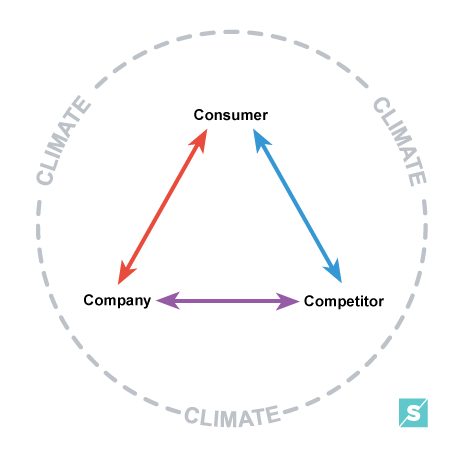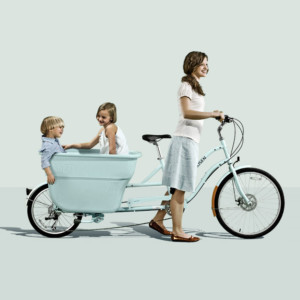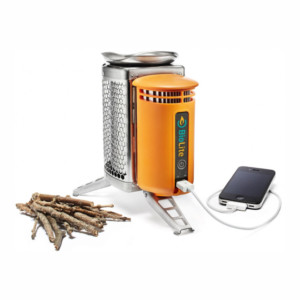Welcome to Part 2 of our 4-part series. In Part 1, I showcased 5 fresh brands that we’ll use as case studies for the rest of the series. If you haven’t yet, give that blog a read or a listen.
Today we’re going to look at the disruptive force of our 5 fresh companies, but do it by way of first looking at the dynamics of a competitive marketplace.
The 3C’s Model
The 3C’s Model is an effective clarifier of purpose, but left by itself, it’s insufficient and leaves industries vulnerable to disruption.
One of my favorite exercises with our clients is to address their 3C’s. Basically, I take over the whiteboard and create three columns with these titles at the top of each: Consumer, Competitors, and Company. Then everyone in the room spends the next 30 minutes getting really specific answering pointed questions:
| Consumer | Competitor | Company |
| Who is buying your products or services? What are their problems? Are their problems the same today as they were yesterday? | Who else is trying to solve our customer’s problems? How strong are their solutions? What are your competitors’ weaknesses? | How are we solving our customer’s problems? What is unique about your company? Why are our solutions better than our competitor’s solutions? |
This exercise is effective because it brings tremendous clarity. If you can easily fill out the columns and answer the questions with confidence, then you are in good shape. But if you are unclear of your consumers and your competition, how would you expect to make your company valuable?
In spite of the strengths of the 3C’s Model, it’s incomplete by itself. It ignores the powerful, mysterious force of climate.
The 4th C: Climate
It’s hard to recognize your climate when you are stuck inside of it.
We all know how different climates can be in different parts of the country. For example, the American Southwest is consistently hot and dry weather, and the American South is consistently hot and humid. Nothing is more shocking than hopping out of a plane after traveling from one region to the other.

The funny thing about climate is that we, as humans and as cultures, can adapt quickly. What is at first shocking (high heat in Arizona), starts to feel normal.
The same is true for the climates that surround your Customers / Competitors / Company. What seems normal to you is very strange to someone outside of your climate. Even more than strange, the climate surrounding your industry may be dysfunctional.
Let’s give examples using our five fresh companies.
1. Surf Industry Climate
Preoccupied with lifeless corporate stuff.
It’s ironic that surfing is so cool, yet for the last 15 years, the “surf industry” has been anything but cool.
Nike purchased Hurley in the early 2000s. The next 15 years were defined by all the major players in the surf industry getting dragged through Wall Street: going public, acquisitions, dis-acquisitions, becoming privately held, settling lawsuits with investors, etc. Gnarly stuff.
From the outside, Deus ex Machina saw the climate for what it was–preoccupied. So preoccupied that these surf brands weren’t aware of a rising generation who appreciated adventure and craft, primarily through Instagram. With a quick swipe of the phone, young people experienced mountain tops, road trips, camping on the beach, custom motorbikes, everything! Deus ex Machina created a brand that wove together a new culture for a new generation.
2. Cycling Industry Climate
Preoccupied with overseas manufacturing and remaining competitive.
Like many companies in the hard goods category, the cycling industry was seeing a major shift to manufacturing overseas. It’s cheaper to manufacture overseas, and it assures that you have a strong profit margin to remain competitive.
This new plan only happens when you can continue to make the same bikes with the same caliber that you did when your manufacturer was across the street, not across the ocean. But what happens when people are no longer interested in those same bikes?
Madsen Cycles can come along and create a cool, innovative family bicycle that everyone wants. It’s fun, versatile, and has a culture too. Did we mention that they’re reasonably priced too?
3. Cooler Industry Climate
Fighting for shelf space at Wal-Mart
If you needed a cooler right now, where would you go? Probably to Wal-Mart, Target, Costco, or maybe a sporting goods store. I can assume that Igloo and Coleman know that buyers don’t discriminate, so the only way to win is to nudge out the competition to get on the shelves at big box retailers. This means cutting your per-unit margin with hopes that the massive exposure to shoppers will help you make up the difference. Innovation is not a priority because innovation is expensive.
YETI is founded on the idea that people are ready for innovation. People want a mind-blowing ice chest, and if you keep our ice cold, we’ll be so stoked that we’ll hand you our hard earned money. We’ll buy it online and we’ll love you for it. You won’t even have to worry about big box retailers.
4. Camping Gear Climate
How much are you willing to spend?
So there are two ways to prepare for a weekend campout: spend $200 at Wal-Mart or spend $2000 at REI. If you make camping products like tents, sleeping bags, and footwear, you had to decide which kind of camper that you want to appeal to.
But what if there was a different kind of camping? Poler Stuff believed that there was a new kind of casual camper who wanted a sleeping bag that they could use more than twice a year. And a backpack that would work for a trip to the coffee shop or a trip to the beach. This new casual camper is willing to pay more for edgy style too. Now they have fans who aren’t just campers, but skaters, surfers, and creative types too. Poler Stuff has created a new market.
5. Camp Stove Climate
Fixated on the camp stove as an appliance.
Not long ago I went to REI to explore, and I was disappointed that the camp stoves looked pretty much like what I had 20 years ago when I was in Boy Scouts. Stove makers had little new and cool to offer backpackers. Maybe a new color, a new feature. Nothing inspiring.
BioLite decided not to compete by creating a new color of the same stove. Instead, they looked squarely at the issue of providing off-grid energy. Why not start with backpackers? Culture was shifting, and it’s acceptable to bring a phone into the great outdoors. Why not? There are cool backpacking apps that can boost the adventure. Plus, BioLite’s focus on off-grid energy opens up many new opportunities beyond camping.
Lesson: Disrupt or be Disrupted
Each of our 5 fresh companies recognized changing climates and responded with disruptive strategies. What does this mean for you?
1) For Industry Insiders
If you are a leader at your company, your best first step is to bring the smartest minds in your organization into the same room. Your objective is to answer this question:
What industry rules or norms, explicit and implicit, will be gone in 2 years? What will be gone in 3 years?
This exercise is challenging because people don’t like showing vulnerability or looking stupid. So they’ll be hesitant to say something radical. So it helps to have your team prepare their answers anonymously and drop them in a hat. As you lift out the anonymous notes and read off each person’s predictions of the changing climate, you’ll find that your exercise gets momentum very fast.
If there is consensus amongst your team that there are 2-3 norms that will soon be gone, you are ready to move on to the more exciting question:
If you know that these norms will soon be gone, why not ignore them now?
…and if you did ignore these norms now, how would it change the plans for the next four quarters?
2) For Industry Outsiders
If you are standing outside an industry, you have the benefit of seeing their climate for what it is. Be eager to learn, of course, but don’t get lost trying to make sense in a dysfunctional climate.
Don’t wait for the “industry’s permission” to make something awesome. Don’t waste your time trying to become an insider. Stay focused on the customers and solve their problems in a new and creative way. People will love you for it. Investors will get excited. Great things will happen!
Let me know what you are up to so I can become a fan: http://twitter.com/mattsmithhouse/
Next time, in Part 3 of the blog series, we’ll talk about the market value of collaborations.
Finally, in Part 4, we’ll talk about an ad-free era of marketing and the power of the tribe.





